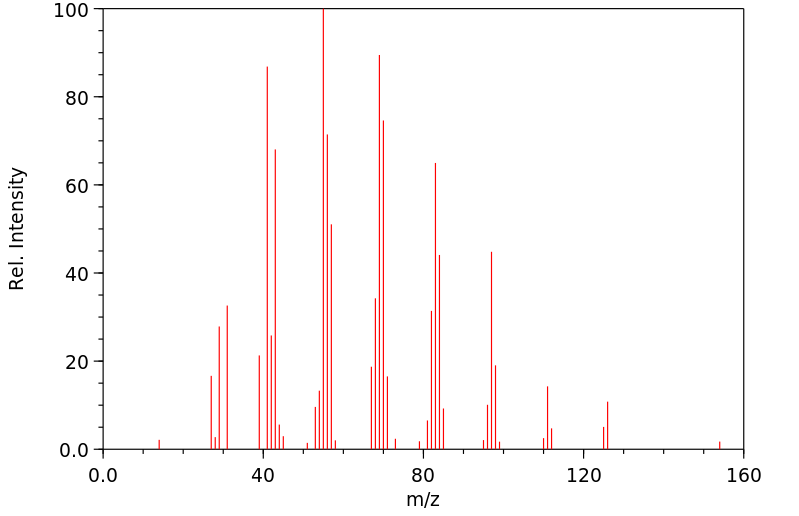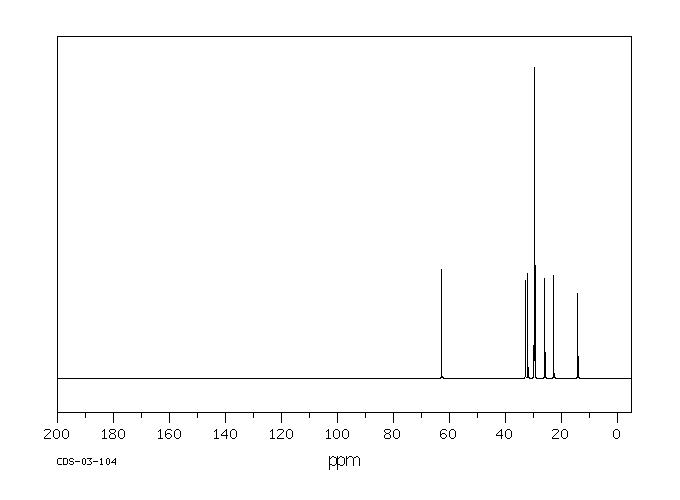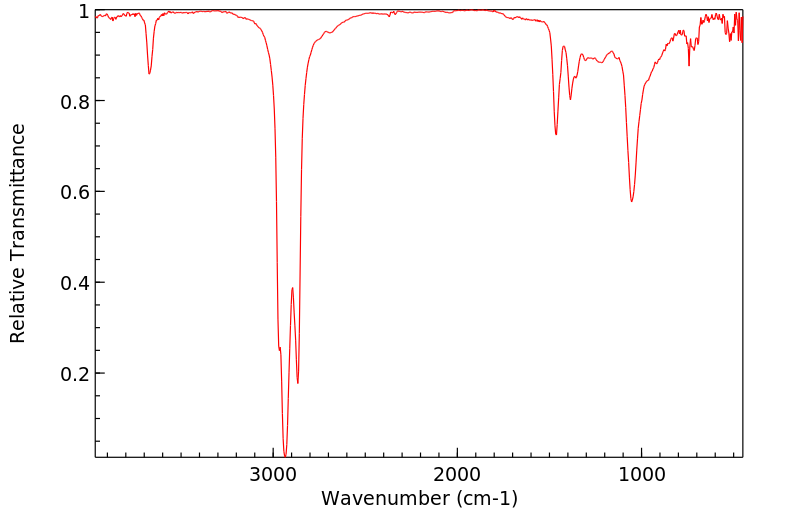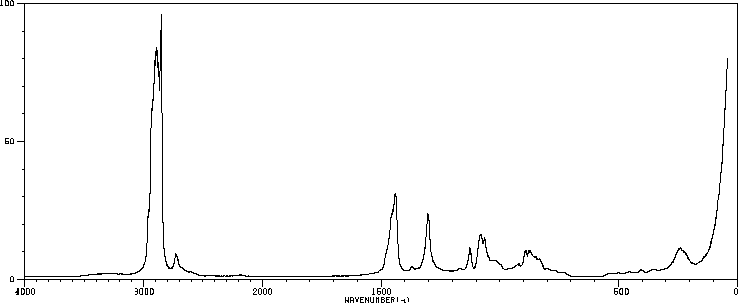十一烷醇 | 112-42-5
-
物化性质
-
计算性质
-
ADMET
-
安全信息
-
SDS
-
制备方法与用途
-
上下游信息
-
文献信息
-
表征谱图
-
同类化合物
-
相关功能分类
-
相关结构分类
物化性质
-
熔点:11 °C (lit.)
-
沸点:146 °C/30 mmHg (lit.)
-
密度:0.83 g/mL at 25 °C (lit.)
-
闪点:>230 °F
-
溶解度:水中的溶解度为0.0057g/l
-
介电常数:5.9800000000000004
-
LogP:4.9 at 20℃
-
物理描述:1-undecanol appears as a water-white liquid with a mild odor. Flash point 250°F. Slightly soluble in water. Considered a marine pollutant by DOT. Immediate steps should be taken to limit its spread to the environment. As a liquid it can easily penetrate the soil and contaminate groundwater or streams. Mildly irritating to both the eyes and skin.
-
颜色/状态:Colorless liquid
-
气味:Citrus
-
味道:FATTY FLAVOR
-
蒸汽压力:2.97X10-3 mm Hg at 25 °C (est)
-
分解:When heated to decomposition it emit acrid smoke and irritating fumes.
-
粘度:17.2 mPa.s at 20 °C
-
折光率:Index of refraction = 1.43918 at 20 °C/D
-
保留指数:1356;1355;1358;1361;1356;1364.6;1355.1;1359.91;1363;1363.3;1364.3;1380.4;1356.4;1347;1348;1348;1348;1349;1349;1350;1360;1361;1363;1365;1367;1368;1363;1367;1357;1356;1357;1358;1351;1364;1381;1362;1349;1354;1364;1357;1357;1356.4
计算性质
-
辛醇/水分配系数(LogP):4.6
-
重原子数:12
-
可旋转键数:9
-
环数:0.0
-
sp3杂化的碳原子比例:1.0
-
拓扑面积:20.2
-
氢给体数:1
-
氢受体数:1
ADMET
安全信息
-
TSCA:Yes
-
危险等级:9
-
危险品标志:Xi,N
-
安全说明:S36/37,S37,S61
-
危险类别码:R51/53,R43,R38
-
WGK Germany:2
-
海关编码:2905199090
-
危险品运输编号:UN 3082 9/PG 3
-
危险类别:9
-
RTECS号:YQ3155000
-
包装等级:III
-
危险性防范说明:P501,P273,P260,P270,P264,P280,P391,P314,P337+P313,P305+P351+P338,P301+P312+P330
-
危险性描述:H302,H319,H372,H410
SDS
制备方法与用途
1-十一醇是一种有机化学品,分子式为C₁₁H₂₄O。它呈无色或浅黄色液体状态,并带有柠檬香味。不溶于水,但能溶于醇和醚中。这种醇可通过多种方法制备,包括从十一酸乙酯经金属钠还原、由ω-十一烯酸乙酯加压催化氢化还原以及通过正壬基溴化镁与环氧乙烷进行格氏反应制得。1-十一醇的应用较为有限,在低温下会呈固态,通常仅作为协调成分用于柑橘类和玫瑰型香精中。
性状在室温条件下,1-十一醇为无色液体,具有淡甜脂蜡香气,并带有玫瑰花香及柑橘、凤梨的果香。其香味主要以玫瑰香为主,且伴有芸香气息;高度稀释时则有类似桔子的气味。浓度低于20×10⁻⁶时,它能产生果香和甜味,而当浓度较高时,则会散发出不愉快的脂质及味。熔点在15~19℃之间,闪点大于82℃,密度为D₄₂₅0.828~0.834,折射率为nD₂₀0.4370~1.4430。该物质不溶于水,但能溶于大多数有机溶剂,并且在60%乙醇中的溶解度为1:4。
制备方法1-十一醇可通过从十一碳醛的还原制得。具体步骤包括:在一个5升三颈瓶中加入200毫升无水甲苯和70克钠,加热至回流直至钠完全熔化。随后停止加热并快速搅拌,使钠分散成沙状,继续搅拌直到温度降至60℃左右。接着分批次加入107克十一烷酸乙酯与150毫升无水乙醇的混合液以及500毫升无水乙醇。待反应减缓后,在油浴中加热至钠完全溶解并消失为止。通过蒸汽蒸馏去除乙醇,再用60%乙醇提取产物。最终得到的液体即为1-十一醇。
化学性质1-十一醇是一种无色油状液体,沸点241℃,熔点大于15℃,相对密度为0.828~0.834,折射率为1.437~1.443。其闪点超过100℃且能溶于60%乙醇及油质香料中,并具有淡甜脂蜡香气、玫瑰花香和柑橘、凤梨的果香。香味是典型的柑橘果油脂气,柔和而甜美。
用途该物质应用范围有限,常与十一烯醛或其他脂肪醛联合使用以作为醛香头香的调和剂。1-十一醇亦可用于与花香型、柑橘古龙、金合欢、刺槐、晚香玉、紫罗兰、清香及草香等成分进行良好的协调,并主要用于玫瑰香基的调配中,还可用作少量添加到凤梨、柑橘、柠檬、白柠檬、桔子、橙子以及黑醋粟和玫瑰食用香精中。
生产方法 分类易燃液体
毒性分级中毒
急性毒性口服 - 大鼠 LD₅₀:3000毫克/公斤
刺激数据皮肤 - 兔子 500毫克/24小时 中度
可燃性危险特性易燃;燃烧时会产生刺激烟雾
储运特性应储存在通风、低温和干燥的库房中
灭火剂干粉、泡沫、砂土及水均可用于灭火。
上下游信息
-
上游原料
中文名称 英文名称 CAS号 化学式 分子量 1,11-十一烷二醇 undecane-1,11-diol 765-04-8 C11H24O2 188.31 10-十一炔醇 undec-10-yn-1-ol 2774-84-7 C11H20O 168.279 10-十一烯-1-醇 10-Undecen-1-ol 112-43-6 C11H22O 170.295 11-溴-1-十一醇 1-Bromo-11-hydroxyundecane 1611-56-9 C11H23BrO 251.207 —— 1-ethoxyundecane 78371-01-4 C13H28O 200.365 十一烷酸 undecylenic acid 112-37-8 C11H22O2 186.294 -
下游产品
中文名称 英文名称 CAS号 化学式 分子量 1,11-十一烷二醇 undecane-1,11-diol 765-04-8 C11H24O2 188.31 1-氢过氧十一烷 Undecyl-hydroperoxid 95590-84-4 C11H24O2 188.31 —— 12-hydroxy dodecanal 95855-71-3 C12H24O2 200.321 十二碳-11-烯-1-醇 dodec-11-en-1-ol 35289-31-7 C12H24O 184.322 2-甲基-十一烷醇 2-methyl-1-undecanol 10522-26-6 C12H26O 186.338 正十一烷基酯 diundecyl ether 43146-97-0 C22H46O 326.607 十一烷酸 undecylenic acid 112-37-8 C11H22O2 186.294 —— chloromethyl undecyl ether 24566-93-6 C12H25ClO 220.783 —— formic acid undecyl ester 5454-24-0 C12H24O2 200.321
反应信息
-
作为反应物:参考文献:名称:铁催化剂上醇和酮的有效气相脱氧摘要:讨论了一种在600 K和1-2·10 5 Pa下铁催化剂上将醇和酮气相脱氧为烃的方法。DOI:10.1016/s0040-4039(00)98301-1
-
作为产物:描述:10-烯酸甲酯 在 Dichlorobis(2-(二苯基膦)乙胺)钌(II) 、 RuCl2(PPh3)[(EtSC2H4)2NH] 、 氢气 、 sodium methylate 、 苯甲醚 作用下, 40.0 ℃ 、500.01 kPa 条件下, 反应 72.0h, 生成 十一烷醇参考文献:名称:用钌催化剂选择性氢化不饱和酯和醛的可持续方法摘要:温和条件下的选择性:比较了三种最先进的市售 Ru 催化剂在 40 °C 和 5 bar 氢气条件下以苯甲醚为溶剂选择性氢化含有 C=C 的酯和醛。DOI:10.1002/cctc.202300394
-
作为试剂:描述:2-Bromo-5,8,11,14,17-pentadodecylhexa-peri-hexabenzocoronene 在 十一烷醇 作用下, 以78%的产率得到参考文献:名称:功能化六邻六苯并芘烯的合成与自组装摘要:先前已通过扫描隧道显微镜 (STM) 和扫描隧道光谱 (STS) 研究了六邻六苯并可罗烯 (HBC) 1b 的六烷基取代衍生物的单层。预计连接到芳香核的不同官能团(给电子或吸电子)将影响堆积模式,也可能影响电流-电压特性。为了提供合适的模型系统,开发了一种新的合成方法来合成功能化的 HBC 衍生物。这是通过适当溴取代的二苯基乙炔和 2,3,4,5-四芳基环戊二烯-2,4-二烯-1-酮的 [4 + 2]-环加成,然后用氯化铁 (III)/硝基甲烷氧化环脱氢来实现的. 使用该策略合成了三种不同的取代模式:2-bromo-5、8,11.14,17-pentadodecylhexa-pecri-hexabenzocoronene (2a), 2,5-dibromo-8,11,14,17-pentadodecylhexa-peri-hexabenzocoronene (2b), 和 2,11-dibromo5DOI:10.1002/1521-3765(20001201)6:23<4327::aid-chem4327>3.0.co;2-7
文献信息
-
Pharmaceutical compositions of drug-oligomer conjugates and methods of treating diseases therewith申请人:——公开号:US20030069170A1公开(公告)日:2003-04-10Pharmaceutical compositions that include a drug-oligomer conjugate, a fatty acid component, and a bile salt component are described. The drug is covalently coupled to an oligomeric moiety. The fatty acid component and the bile salt component are present in a weight-to-weight ratio of between 1:5 and 5:1. Methods of treating diseases in a subject in need of such treatment using such pharmaceutical compositions are also provided, as are methods of providing such pharmaceutical compositions.
-
Insulin polypeptide-oligomer conjugates, proinsulin polypeptide-oligomer conjugates and methods of synthesizing same申请人:——公开号:US20030229009A1公开(公告)日:2003-12-11Methods for synthesizing proinsulin polypeptides are described that include contacting a proinsulin polypeptide including an insulin polypeptide coupled to one or more peptides by peptide bond(s) capable of being cleaved to yield the insulin polypeptide with an oligomer under conditions sufficient to couple the oligomer to the insulin polypeptide portion of the proinsulin polypeptide and provide a proinsulin polypeptide-oligomer conjugate, and cleaving the one or more peptides from the proinsulin polypeptide-oligomer conjugate to provide the insulin polypeptide-oligomer conjugate. Methods of synthesizing proinsulin polypeptide-oligomer conjugates are also provided as are proinsulin polypeptide-oligomer conjugates. Methods of synthesizing C-peptide polypeptide-oligomer conjugates and other pro-polypeptide-oligomer conjugates are also provided.
-
The Oxidation of Alcohols in<i>N</i>-Oxyl-Immobilized Silica Gel/Aqueous NaOCl Disperse Systems. A Prominent Access to a Column-Flow System作者:Hideo Tanaka、Jingyu Chou、Machiko Mine、Manabu KuroboshiDOI:10.1246/bcsj.77.1745日期:2004.9The oxidation of alcohols was performed successfully in a disperse system with N-oxyl-adsorbed or immobilized silica gel as a disperse phase and aqueous NaOCl as a disperse medium. In the disperse system, the oxidation of sec-alcohols afforded the corresponding ketones, while prim-alcohols were oxidized to aldehydes and/or carboxylic acids depending on their structures and reaction conditions. The N-oxyl-immobilized silica gel was recovered and repeatedly used without a significant change in the product yields. A column-flow system was also investigated for the oxidation of alcohols by use of a newly devised column packed with the N-oxyl-immobilized silica gel.
-
A Versatile Iridium(III) Metallacycle Catalyst for the Effective Hydrosilylation of Carbonyl and Carboxylic Acid Derivatives作者:Yann Corre、Vincent Rysak、Xavier Trivelli、Francine Agbossou-Niedercorn、Christophe MichonDOI:10.1002/ejoc.201700801日期:2017.9.1IrIII metallacycle rapidly and selectively catalyses the reduction of various esters, carboxylic acids, ketones, and aldehydes. The reactions proceed in high yields at room temperature by hydrosilylation followed by desilylation. Depending on the substrate, esters are reduced to alcohols or ethers and carboxylic acids to alcohols or aldehydes.
-
USE OF NITROGEN COMPOUNDS QUATERNISED WITH ALKYLENE OXIDE AND HYDROCARBYL-SUBSTITUTED POLYCARBOXYLIC ACID AS ADDITIVES IN FUELS AND LUBRICANTS申请人:BASF SE公开号:US20160130514A1公开(公告)日:2016-05-12The invention relates to the use of quaternized nitrogen compounds as a fuel and lubricant additive or kerosene additive, such as in particular as a detergent additive, for decreasing or preventing deposits in the injection systems of direct-injection diesel engines, in particular in common rail injection systems, for decreasing the fuel consumption of direct-injection diesel engines, in particular of diesel engines having common rail injection systems, and for minimizing the power loss in direct-injection diesel engines, in particular in diesel engines having common rail injection systems; the invention further relates to the use as an additive for petrol, in particular for operation of DISI engines.该发明涉及将季铵化氮化合物用作燃料和润滑剂添加剂或煤油添加剂,特别是作为清洁剂添加剂,用于减少或预防直喷柴油发动机的喷射系统中的沉积物,在特定是在共轨喷射系统中,用于降低直喷柴油发动机的燃料消耗,特别是具有共轨喷射系统的柴油发动机,并用于减少直喷柴油发动机的功率损失,特别是在具有共轨喷射系统的柴油发动机中;该发明还涉及将其用作汽油添加剂,特别是用于DISI发动机的运行。
表征谱图
-
氢谱1HNMR
-
质谱MS
-
碳谱13CNMR
-
红外IR
-
拉曼Raman
-
峰位数据
-
峰位匹配
-
表征信息










